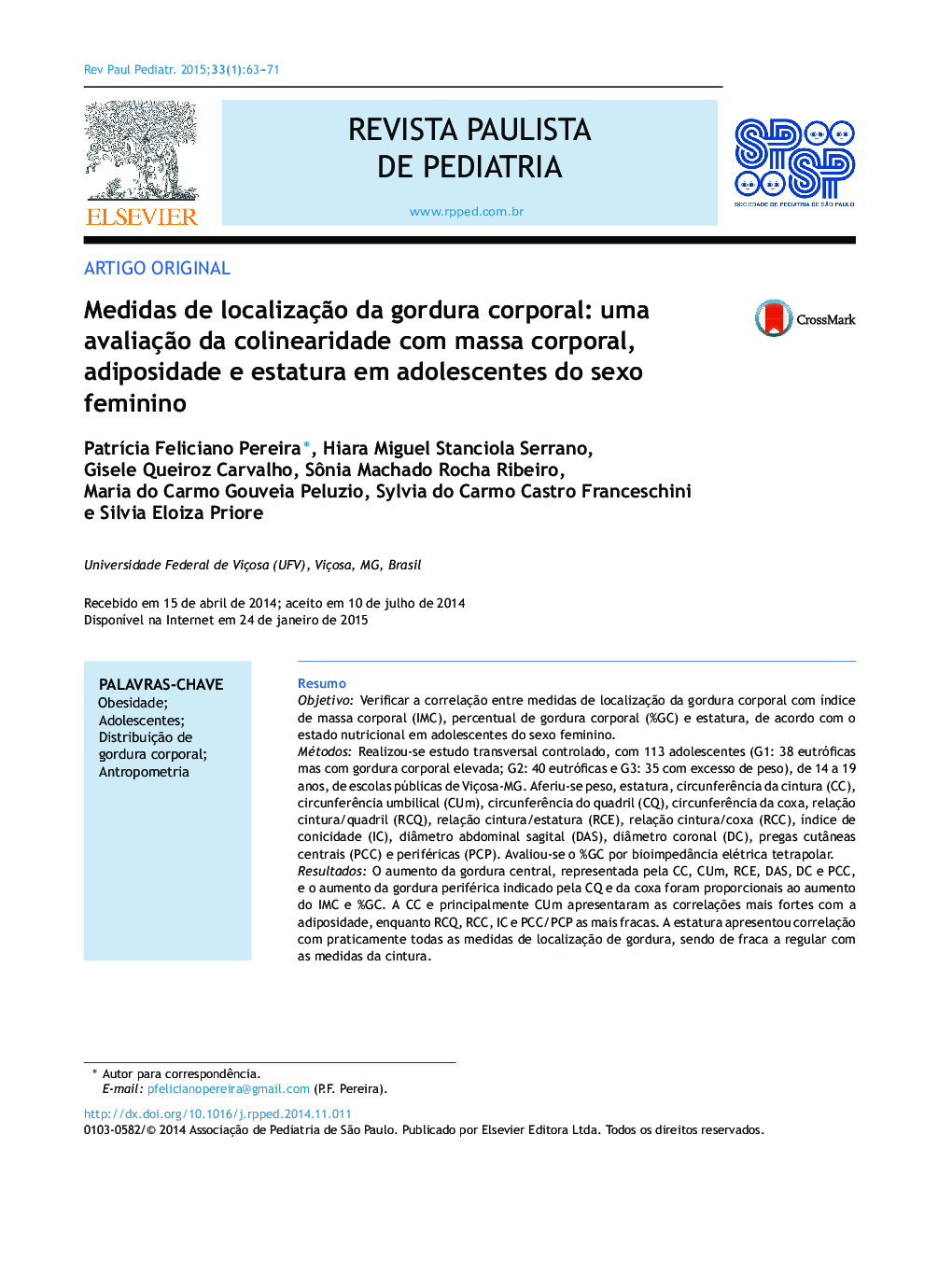| Article ID | Journal | Published Year | Pages | File Type |
|---|---|---|---|---|
| 4176026 | Revista Paulista de Pediatria | 2015 | 9 Pages |
ResumoObjetivoVerificar a correlação entre medidas de localização da gordura corporal com índice de massa corporal (IMC), percentual de gordura corporal (%GC) e estatura, de acordo com o estado nutricional em adolescentes do sexo feminino.MétodosRealizou‐se estudo transversal controlado, com 113 adolescentes (G1: 38 eutróficas mas com gordura corporal elevada; G2: 40 eutróficas e G3: 35 com excesso de peso), de 14 a 19 anos, de escolas públicas de Viçosa‐MG. Aferiu‐se peso, estatura, circunferência da cintura (CC), circunferência umbilical (CUm), circunferência do quadril (CQ), circunferência da coxa, relação cintura/quadril (RCQ), relação cintura/estatura (RCE), relação cintura/coxa (RCC), índice de conicidade (IC), diâmetro abdominal sagital (DAS), diâmetro coronal (DC), pregas cutâneas centrais (PCC) e periféricas (PCP). Avaliou‐se o %GC por bioimpedância elétrica tetrapolar.ResultadosO aumento da gordura central, representada pela CC, CUm, RCE, DAS, DC e PCC, e o aumento da gordura periférica indicado pela CQ e da coxa foram proporcionais ao aumento do IMC e %GC. A CC e principalmente CUm apresentaram as correlações mais fortes com a adiposidade, enquanto RCQ, RCC, IC e PCC/PCP as mais fracas. A estatura apresentou correlação com praticamente todas as medidas de localização de gordura, sendo de fraca a regular com as medidas da cintura.ConclusõesOs resultados indicam colinearidade entre massa corporal e adiposidade total com tecido adiposo central e periférico. Recomenda‐se o emprego da CUm na avaliação do estado nutricional de adolescentes, pois ela apresentou maior capacidade para predizer adiposidade em cada grupo, além de correlação fraca a regular com a estatura.
ObjectiveTo verify the correlation between body fat location measurements with the body mass index (BMI), percentage of body fat (%BF) and stature, according to the nutritional status in female adolescents.MethodsA controlled cross sectional study was carried out with 113 adolescents (G1: 38 eutrophic, but with high body fat level, G2: 40 eutrophic and G3: 35 overweight) from public schools in Viçosa‐MG, Brazil. The following measures have been assessed: weight, stature, waist circumference (WC), umbilical circumference (UC), hip circumference (HC), thigh circumference, waist‐to‐hip ratio (WHR), waist‐to‐stature ratio (WSR), waist‐to‐thigh ratio (WTR), conicity index (CI), sagittal abdominal diameter (SAD), coronal diameter (CD), central skinfolds (CS) and peripheral (PS). The %BF was assessed by tetrapolar electric bioimpedance.ResultsThe increase of central fat, represented by WC, UC, WSR, SAD, CD and CS, and the increase of peripheral fat indicated by HC and thigh were proportional to the increase of BMI and %BF. WC and especially the UC showed the strongest correlations with adiposity. Weak correlation between WHR, WTR, CI and CS/PS with adiposity were observed. The stature showed correlation with almost all the fat location measures, being regular or weak with waist.ConclusionsThe results indicate colinearity between body mass and total adiposity with central and peripheral adipose tissue. We recommend the use of UC for assessing nutritional status of adolescents, because it showed the highest ability to predict adiposity in each group, and also presented regular or weak correlation with stature.
